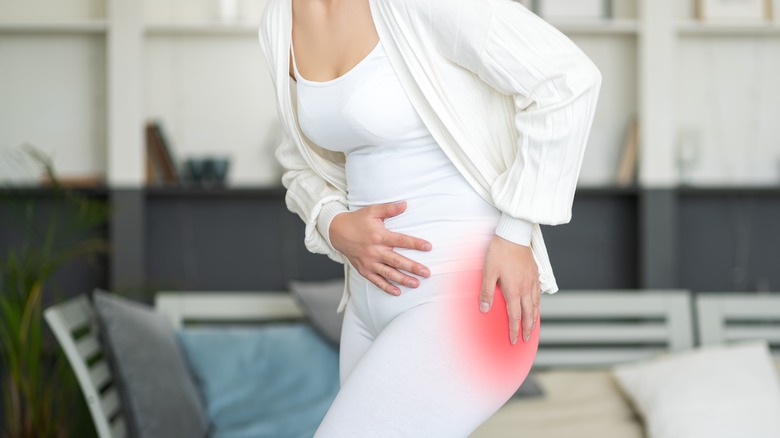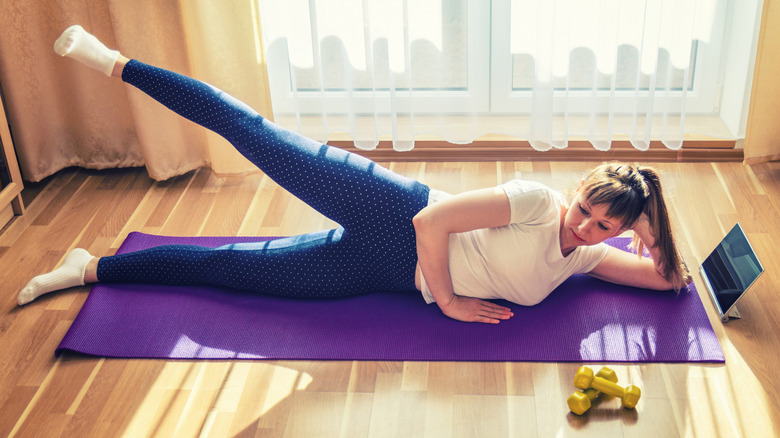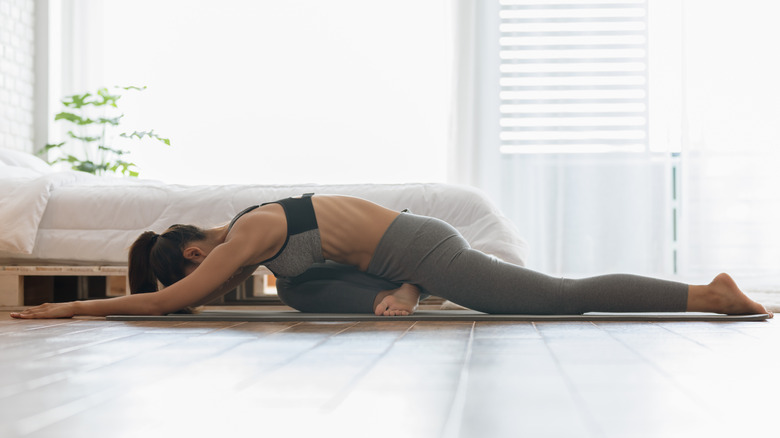The Best Exercises For Hip Bursitis
Approximately half of older adults report experiencing hip pain, usually due to arthritis. However, younger people can experience hip pain as well, often as a result of hip deformities, according to Dr. Geoffrey Van Thiel, an arthroscopic surgeon.
The American Academy of Orthopaedic Surgeons says a common source of hip pain is bursitis. Bursitis is inflammation of small sacs of fluid called bursae. These sacs serve as cushions between soft tissue and bones in the body and can be found around many joints, including the hips. Under normal circumstances, bursae protect joints by reducing friction. However, when these small cushioning sacs become inflamed, the result can be immensely painful.
In the hip, there are two bursae sacs that are at risk of irritation. One of the sacs is responsible for cushioning the greater trochanter, which is the hip bone's bony point. Inflammation of this bursa is referred to as trochanteric bursitis. The second sac is called the iliopsoas bursa. Instead of being situated in the hip, it's actually located inside the groin. However, given its close alignment with the hip, the result is hip pain similar to trochanteric bursitis.
Hip pain can easily disrupt your day. If you experience hip pain, you probably want to find a way to feel better ASAP. The quest for treating hip pain can be frustrating, but there are many ways to manage and even rid yourself of pain, including specific exercises.
Focus on leg exercise to help hip bursitis
To treat hip pain, it may seem odd to focus on another part of your body, but easing pain from hip bursitis can be accomplished by doing exercises that strengthen your legs. These exercises reduce bursae inflammation by taking pressure off of your hip joints (via Healthline).
Two exercises to decrease hip pain are lying lateral leg raises and lying leg circles. Both exercises are low impact and can strengthen muscles that support your hips without intense exertion. For both of these leg exercises, no equipment is needed, though you may wish to use a yoga mat or lay on a cushioned area for comfort, suggests Healthline.
For lying lateral leg raises, position yourself on your side with your bottom arm extended to maintain your body's balance. Lift your top leg up as high as you can without moving your body out of a straight position on the floor. Slowly move your leg up and down so that it aligns with your bottom leg and then lift it up again. Try to complete 15 repetitions.
Lying leg circles are performed by positioning yourself flat on your back with your legs extended and one leg raised approximately 3 inches off the ground. Maintaining a straight leg the entire time, use controlled movements to make small circles with the raised leg. Then do the same exercise with the other leg.
Stretching exercises help hip pain too
Hip bridges are one of the best exercises to treat pain from hip bursitis, per Healthline. To perform a hip bridge, lie on your back with bent knees and feet flat on the floor, about hip-width apart. In a slow, regulated motion, lift your hips up until they're at the height of your knees and shoulders, or as high as you are able to lift your hips and glutes to feel a stretch without straining. With control, slowly move your hips back to the floor. Then repeat. Always listen to your body and never push yourself beyond your limits or you may risk further injury and pain.
Certain yoga poses can also help relieve hip pain by increasing flexibility in the glutes and hamstrings (via Insider). Specifically, pigeon pose can loosen tight hips and soothe related pain. For the pose, start in downward dog, or a seated position if you need to modify. Getting into pigeon pose, bring one knee to your elbow and ease your way into a stretch with your shin facing the opposite hip. Move your opposite leg into a straight position behind you with the knee touching the floor as your front leg settles on the floor in front of you. Carefully lean forward until you feel a gentle stretch, but don't push yourself into too deep of a stretch.



